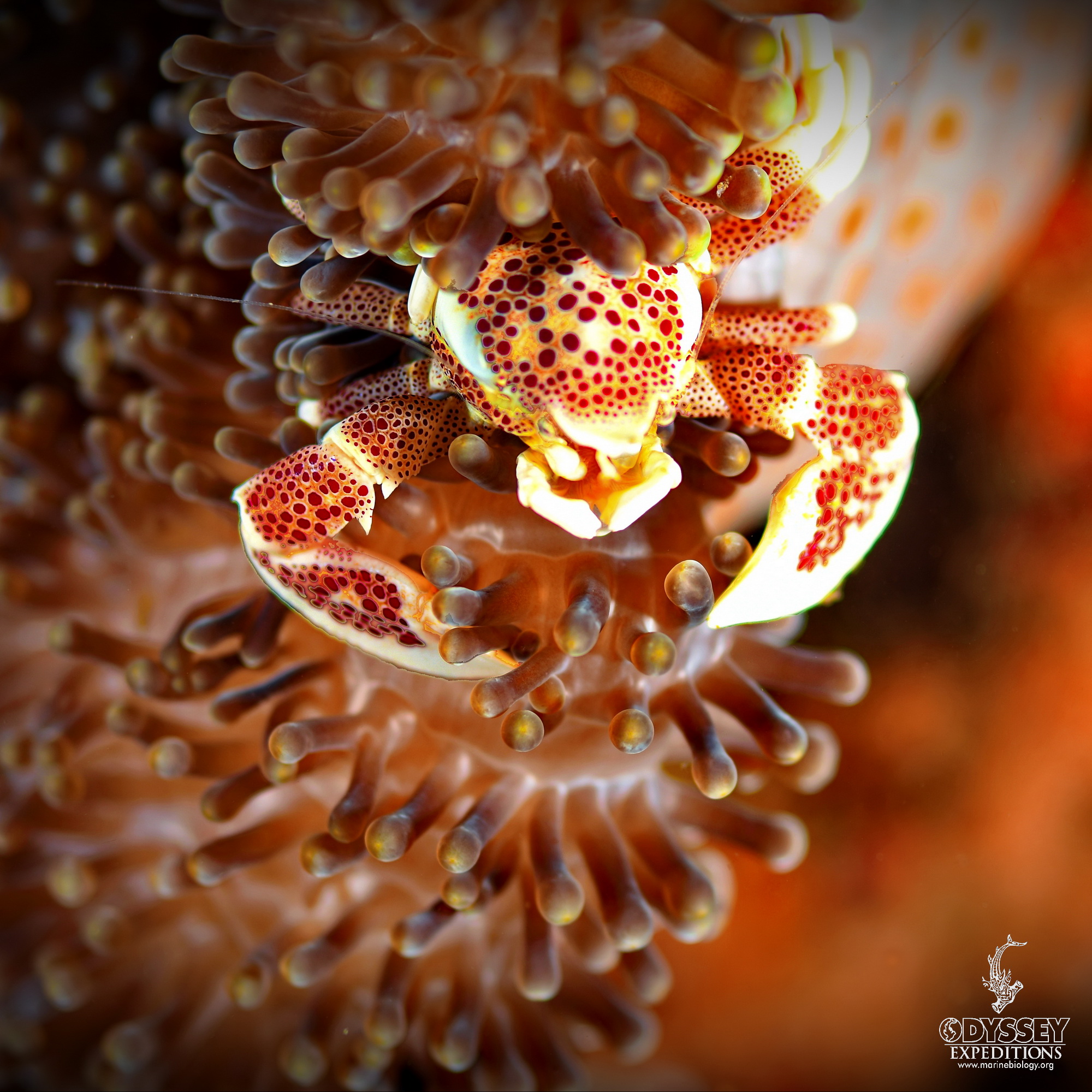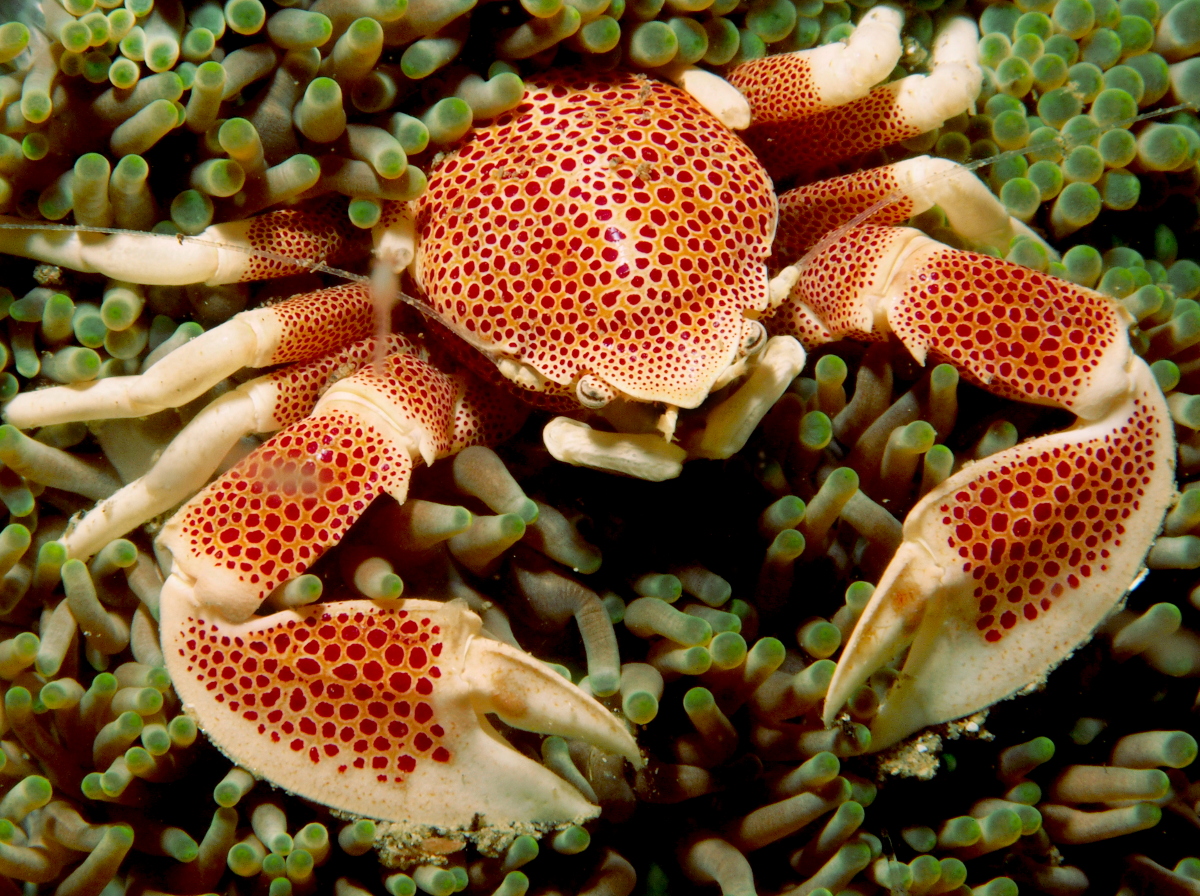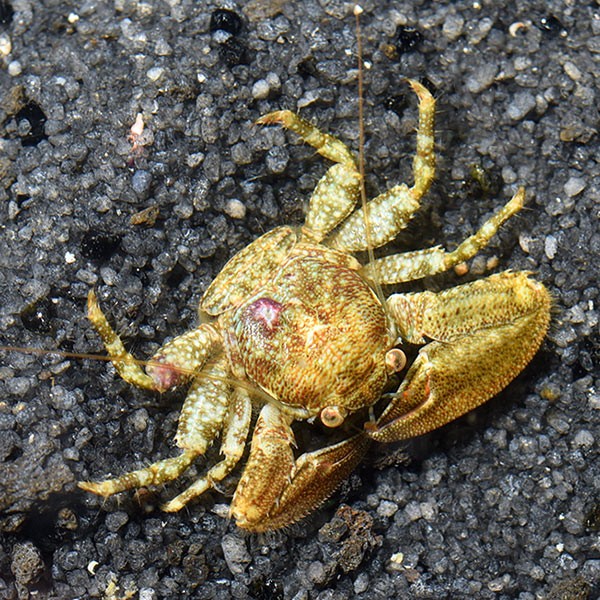
Porcelain crab (Neopetrolisthes maculatus) Lembeh Resort Dive Resort
Have you ever heard of a porcelain crab? This small, fragile-looking creature is one of the most beloved reef inhabitants. It can be a bit shy and reclusive, but it also plays an important role in keeping the reef healthy and thriving. Let's take a look at some interesting facts about porcelain crabs and why they make great additions to reef tanks.

Porcelain Anemone Crab Facts and Photographs • Seaunseen
Porcelain crabs are filter feeders and have large feathery mouthparts for collecting food from the water column. The large claws are therefore used defensively, but are more likely to be autotomised (fall off) to distract predators, much in the same way a lizards tail is. Morphology

Porcelain Crab Stock Image C031/6767 Science Photo Library
Porcelain crabs from the closely related genera Petrolisthes, Liopetrolisthes, and Allopetrolisthes are known for their diversity of lifestyles, habitats, and coloration. The evolutionary relationships among the species belonging to these three genera is not fully resolved.

Porcelain Anemone Crab Facts and Photographs • Seaunseen
True Crab Vs. Porcelain Crab The porcelain crabs look like a crabs, but are not true crabs. Unlike true crabs, the porcelain crabs have long antennae. They have three pairs of walking legs, whereas true crabs have four pairs. In porcelain crabs, the fourth pair of legs are too small and are not visible, as they are held against their body.

Spotted Porcelain Crab Marine Biology Learning Center
Porcellanidae, commonly known as porcelain crabs, is a family of decapods belonging to the infraorder Anomura. Therefore, Porcelain Anemone crabs are not true crabs. They superficially resemble true crabs and have flattened bodies adapted to living in crevices and under rocks. However, they are more related to hermit crabs than crabs.

Porcelain Crab Feeding by Eugene Lim / 500px
Porcelain crabs are decapod crustaceans in the widespread family Porcellanidae, which superficially resemble true crabs. They have flattened bodies as an adaptation for living in rock crevices. They are delicate, readily losing limbs when attacked, and use their large claws for maintaining territories.

PorcelainCrab_1024 (Custom) Dive Into Lembeh
The pea crab is a small crab that is a parasite of oysters, clams, mussels and other species of bivalves. Image © Marck Hicks via Flickr Next:. Lobsters & Crayfish Information about crustaceans in Australia including their biology, anatomy, behaviour, reproduction, predators, prey and ecology.

Spotted Porcelain Crab Neopetrolisthes maculatus Anilao
Cool facts A female porcelain crab less than an inch long may carry nearly 1,600 eggs at a time (though most carry only around 600). Up to 860 porcelain crabs have been found living in a 10-square-foot (one-square-meter) section of a mussel bed off Pacific Grove, California!

Porcelain Anemone Crab Facts and Photographs • Seaunseen
Spiny Porcelain Crabs are active, aggressive animals, but they are probably filter feeders. Their long antennae and small fifth legs distinguish them from true crabs. Distribution Southern Australia. Habitat Intertidal areas under large stones on exposed coasts, to depth of 25 m. More Information Animal Type Crustaceans Animal SubType Crabs

Porcelain Anemone Crab Detailed Guide Care, Diet, and Breeding
Porcelain anemone crab (Neopetrolisthes maculatus) aquarium. This species isn't too fussy about its environment, as long as the aquarium is fully cycled with no traces of ammonia and nitrite, and the water quality is kept high. You can keep a pair in an invertebrate-only aquarium from 10 gallons or up, making the porcelain anemone crab a.

Porcelain Anemone Crab Facts and Photographs • Seaunseen
Discover the Stories Behind Our Unique Antique Porcelain and Works of Art. Rare Chinese Armorial Porcelain Plates, Coats of Arms, Crests.

Porcelain Crab Saltwater Aquarium Invertebrates
Introduction. Porcellanidae, commonly known as porcelain crabs, is a family of decapods belonging to the infraorder Anomura (Crustacea, Decapoda).The group comprises 283 species according to the classification proposed by Osawa and McLaughlin (2010).Like most decapods, their life cycle contains a planktonic larval phase presenting various morphological changes during ontogenic development.

Photos of porcelain crabs family Porcellanidae
The anomuran crustacean family Porcellanidae (porcelain crabs or false crabs) can be easily distinguished from brachyura (true crabs) by having the fifth pereopod which is reduced in size and often hidden beneath the carapace, the antennae with an elongate flagellum and the abdomen which does not fit closely to the underside of the cephalothorax (Poore and Ahyong 2004; Osawa and Chan, 2010).

The Porcelain Crab Smithsonian Ocean
The porcelain crab (Neopetrolisthes maculatus) is a very small crab, with a colorful shell. It lives in anemones in the Indo-Pacific region. It lives in anemones in the Indo-Pacific region. The crab, or family of crabs, that live in and around their anemone have been known to fiercely defend their anemone from potential invaders.

Porcelain Anemone Crab Facts and Photographs • Seaunseen
Is the spiny porcelain crab (Petrocheles australiensis) a true crab or a false crab? (Getty Images: Auscape) abc.net.au/news/crab-convergent-evolution-crustacean-australia-marine-biology/101388282 Few animals are as recognisable as the crab: a rounded, flat body covered in a hard shell, attached to scuttling legs and a pair of pincers.

Real Monstrosities Porcelain Crab
Description Petrolisthes armatus is a porcelain crab (sometimes called a half-crab) with proportionately large claws. The 4th pair of walking legs is vestigial, and the abdomen is more developed than in brachyuran crabs ('true crabs').